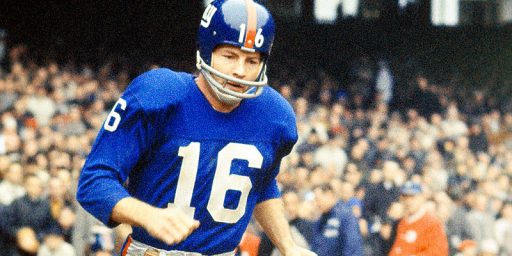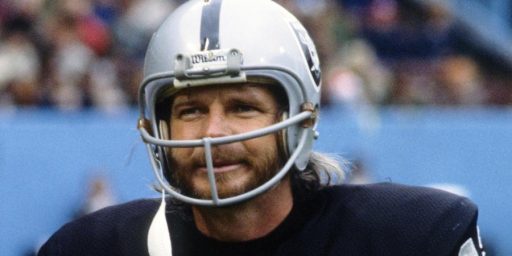Bubba Smith Is Latest Former N.F.L. Player Diagnosed To Have Had C.T.E.
Bubba Smith, the former N.F.L. star who went on to have a successful career as an actor, is the latest former pro football player to be diagnosed as having a degenerative brain disease linked to repeated concussions:
Bubba Smith, the All-Pro defensive end in the N.F.L. who went on to a second career as a movie actor, had chronic traumatic encephalopathy, the degenerative brain disease linked to repeated head trauma, when he died in 2011.
The findings were confirmed by researchers affiliated with the Department of Veterans Affairs, Boston University and the Concussion Legacy Foundation, and released on Tuesday morning with the permission of the executor of Smith’s estate.
Smith is the 90th former N.F.L. player found to have had C.T.E. by the researchers at the Boston University brain bank; they have examined 94 former pro players. On a scale of 1 to 4 used by the neuropathologist who examined Smith’s brain, Smith had Stage 3 C.T.E., with symptoms that included cognitive impairment and problems with judgment and planning.
Some scientists caution that much remains unknown about C.T.E., including why it afflicts some players but not others. But even the N.F.L., which for years denied there was any connection between head trauma sustained on the field and long-term cognitive impairment, has admitted that there is a link.
Smith, whose name was Charles, died at age 66 of an overdose of phentermine, a weight-loss drug. He also had heart disease and high blood pressure, according to the Los Angeles County coroner.
At 6 feet 7 inches and nearly 300 pounds, Smith was known as a quick and powerful lineman. During a standout career at Michigan State, where he was named an all-American in 1965 and 1966, Smith’s size and prowess gave rise to the chant “Kill, Bubba, Kill,” which emanated frequently from the stands. (He later co-wrote a book whose title was the chant.)
Smith was chosen as the No. 1 overall pick in the 1967 draft by the Baltimore Colts. He was a member of the teams that lost Super Bowl III to the Jets and beat the Dallas Cowboys in Super Bowl V. After five seasons in Baltimore, Smith played two seasons with the Oakland Raiders and two seasons in Houston with the Oilers.
After Smith retired following the 1976 season, he used his size and fame to build a second career in film and television. He was best known for his role as Moses Hightower, the mild-mannered florist-turned-lawman in the film comedy “Police Academy” (1984) and many of its sequels.
He appeared on many shows, including “Good Times,” “Charlie’s Angels,” “Semi-Tough,” “Hart to Hart,” “Married With Children” and “Family Matters.” He was also seen in a well-known series of Miller Lite commercials — “Tastes Great; Less Filling” — in the 1970s and ’80s.
Smith joins dozens of notable N.F.L. players found to have had C.T.E., including Junior Seau, Frank Gifford and Ken Stabler, Smith’s teammate on the Raiders.
We’re at the point now, of course, where it no longer comes as a surprise when a former N.F.L. player is determined to have had C.T.E. at the time of their death regardless of whether or not they were exhibiting symptoms, such as the short-term memory loss that Terry Bradshaw has described, suggesting that this is likely to be the case. In nearly all of these cases, the cause of death has been something other than C.T.E., although one can arguably say that those former players who suffered from diagnosed mental disorders and ended up committing suicide arguably can be said to have died due to C.T.E. Whatever the cause of death, though, it seems fairly clear that nearly all of these players had their quality of life in their post-N.F.L. life adversely impacted by this brain disease and that, until recently, neither the league nor the sports media that slavishly covers the league exactly the way the N.F.L. wants have taken this issue seriously. With reports like this, and no doubt more to come, it seems like that is finally changing. The question is what, if anything, the league will do to address the issue.






This is certainly a problem for the NFL and, to a much lesser extent, for the sport itself. Still, there’s something fundamentally different about the early cases highlighting this disease, in which young men recently retired from the game were discovered to have it, and the recent cases where men who lived long lives, often complicated by drug abuse, were diagnosed decades after their playing days.
Dave Mirra, the BMX star who committed suicide back in February, also had CTE. I suspect that James Hetfield will also be diagnosed when he’s gone, and Ozzy probably can be now.
The more we understand about CTE, the less it will be about football. (I hope.)
I remember a kind of stupid TV show about a police helicopter that had a Hollywood type of good looking leading man with Smith and Dick Butkus as minor players. Bubba and Butkus were great together, very funny, and slyly amusing. I wished that they could have had a show to themselves. I hope that Smith’s family will be comforted by the real affection so many had for him.
Personally, I do not watch football any more. My personal enjoyment is outweighed by the destruction of real people that the sport entails. I am still drinking as much beer and eating as much salsa and chips as previously.
@Slugger:
Are we supposed to be impressed with your empathy, your sacrifice, or both?
Seriously, when I hear this “don’t watch football anymore” stuff, I know I’m dealing with someone more concerned with remaining fashionable than they are about player safety.
@James Pearce: This is a good point. I hope that the studies are branching into other sports: hockey (vicious hits, fights. and boarding every night), basketball, soccer, mma, car racing, and WWE (especially).
@James Pearce: You called me “empathetic ” and “fashionable.” Do I really deserved such calumny?
I avoided prescriptive measures in my comments. I do think that football should look at motorsports. Motorsports have altered their rules to increase the safety of the performers without decreasing the competition. F1 has not had a fatality in years. This weekend, the 100th Indy 500 will be held. There is lots of fan interest despite the fact that the safety measures mean a good chance of more injuries from beer and fried chicken to onlookers than harm to the drivers.
This is sad news. Football is one of the sports where the real damage done is often not immediately felt or seen and only surfaces much later. This rash of concusion related illnesses and deaths is so tragic. Hockey is even worse.
@Slugger:
No, and thanks for calling me out for it.
But there is a contingent out there that seeks to use CTE as a weapon in their continuing jihad against football. They claim to be concerned about player safety, and yet their proposed solution isn’t rule changes or equipment modifications, it’s to stop watching football.
Which makes me think their real concern is the aesthetics of the game, and in some cases, its popularity.